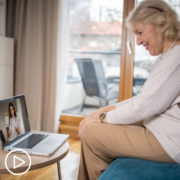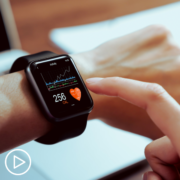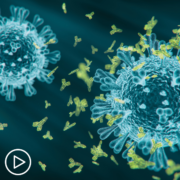Tag Archive for: myeloproliferative neoplasms
Dr. Ana Maria Lopez: Why Is It Important for You to Empower Patients?
Dr. Ana Maria Lopez: Why Is It Important for You to Empower Patients? from Patient Empowerment Network on Vimeo.
Can myeloproliferative neoplasm (MPN) care providers take a different approach to hierarchical patient-provider healthcare? Expert Dr. Ana Maria Lopez from Sidney Kimmel Cancer Center provides insight to the approach she takes to help empower patients in their care experience.
See More from Empowering Providers to Empower Patients (EPEP)
Related Resources:

|

|

|
Transcript:
Dr. Ana Maria Lopez:
I think, I really see myself as a facilitator of the healing process, the patient is the expert in their disease, in their illness process, they are living it every single day. And by having the patient, kind of like what we said earlier, you know the patient has questions, or the patient comes in with a list of questions, that’s great, because the patient is activated…is empowered enough to say, “Hey, these are my concerns.” So I think having a person get to that space or helping them get to that space is really, really important, and then what I can do to help with that is one, is simply to encourage that, that the patient is the expert in their own disease, and how they want to, I want to understand what is the experience like for you? What are your goals, what are your needs, what is most difficult or least difficult, and what is it that we need to address? So that I’m really partnering and really understanding from the patient’s experience, so I think that we’ve had such changes and there used to be the physician and the patient, and very hierarchical.
I tell you what to do. There’s so much information now, and there’s really more of a respect, and I think that’s really important, that respect that we are partners. And ultimately, this is about you, this is about the patient. So “How can I help you?” is I think my approach.
Dr. Krisstina Gowin: Why Is It Important for You to Empower MPN Patients?
Dr. Krisstina Gowin: Why Is It Important for You to Empower MPN Patients? from Patient Empowerment Network on Vimeo.
Empowerment for myeloproliferative neoplasm (MPN) patients is a vital part of their care, but how can providers help with this? Dr. Krisstina Gowin from the University of Arizona shares key ways that she helps empower her patients and explains some reasons why patient empowerment is important in their care.
See More from Empowering Providers to Empower Patients (EPEP)
Related Resources:

|

|

Dr. Ana Maria Lopez Why Is It Important for You to Empower Patients |
Transcript:
Dr. Krisstina Gowin:
I think the first key to empowerment is education. And so anytime I meet a patient, I spend a significant amount of time really making sure they understand their disease and what are the treatment goals, and how do we best achieve those together? And I think for MPNs in particular, that I want them to understand that, yes, we want hematologic response, we want to control your blood counts and your numbers, we want to reduce those thrombotic complications, we want to control your symptom burden, so so important, your quality of life and symptom burden is part of the disease management.
And so I want them to understand what is symptom burden, and how is it measured, and how do we best achieve chronologic measurements? Do they do that at home? Is it best in clinic, are they going to be journaling? So symptom burden and measuring, and then the other is wellness and the management of cardiovascular risk factors, and so education around all of those for my MPN patients.
And then why is it important while it’s important because we want our patients to feel empowered, we want to feel like they are driving the bus and contributing to their own survivorship and wellness, and so how do they best do that is through education and then again, getting the tools they need to really navigate their journey in the most precision and personal, personalized way as possible, and so that’s really my strategy is education and empowerment.
Can Mobile Health Apps Lower the Burden of MPN Symptoms?
Can Mobile Health Apps Lower the Burden of MPN Symptoms? from Patient Empowerment Network on Vimeo.
How can the burden of myeloproliferative neoplasm (MPN) symptoms be lessened through the use of mobile health apps? Blood cancer patient Lisa Hatfield shares common MPN symptoms that patients experience and explains wellness strategies and mobile app study results that decreased the symptom burden for patients.
See More from MPN TelemEDucation
Related Resources:

|

|

|
Transcript:
Lisa Hatfield:
As an MPN patient, you might experience symptoms like fatigue, night sweats, difficulty sleeping, abdominal discomfort, bone pain and others. However, early data using integrative approaches for the treatment of MPNs are promising, including aerobic activity, yoga, meditation, and strength training, to reduce the symptom burden and improve inflammation. With the evolution of smartphone technology, mobile apps have been increasingly popular to document wellness strategies. With this in mind, the University of Arizona Andrew Weil Center for Integrative Medicine developed and successfully piloted a global wellness mobile app, My Wellness Coach (MWC), to guide MPN patients on self-management strategies for their symptom burden.
The app had patients set at least two wellness goals with clear action steps within these seven areas: nutrition, movement, sleep, resilience, environment, relationships and spirituality to work on over the course of 12 weeks. Within the app, there were links to curated resources and tips. Participants were sent 24- to 72-hour interval reminders before and after each action step and a goal deadline to encourage action throughout the intervention. At the end of the study, improvements were observed in inactivity, impaired concentration, dizziness, numbness, sexual dysfunction, night sweats, bone pain, and quality of life.
If you’d like to implement something similar to what the participants did, try the following:
- Reflect on why you want to change your symptom burden so you feel motivated
- Determine which of these categories: nutrition, movement, sleep, resilience, environment, relationships, and spirituality would you like to set goals in
- Create two goals from those categories and make them SMART- specific, measurable, attainable, relevant, and time-bound.
- Utilize resources available to you through support groups or online tools
- Set reminders on your phone or calendar for each step you need to take to complete your SMART goals
Mobile-based apps are another example of how MPN patients can use telemedicine in their day-to-day life and improve care.
Share Your Feedback:
Create your own user feedback survey
How Can MPN Patients Continue to Use Telemedicine and Overcome Barriers?
How Can MPN Patients Continue to Use Telemedicine and Overcome Barriers? from Patient Empowerment Network on Vimeo.
What ways can myeloproliferative neoplasm (MPN) patients continue to use telemedicine to overcome barriers? Blood cancer patient Lisa Hatfield shares advice for coordinating with your MPN care provider to continue telemedicine visits and how to advocate for continued coverage of virtual visits.
See More from MPN TelemEDucation
Related Resources:

|

|

|
Transcript:
Lisa Hatfield:
If you got used to and liked doing telemedicine appointments rather than going to in-person appointments during the COVID-19 pandemic, don’t worry – it seems like telemedicine is here to stay! In order to take forward what we have learned from telemedicine during the pandemic, here are a few things to keep in mind.
- Make sure you tell your doctor that you enjoyed telemedicine visits and would like to keep using them as much as possible. You and your doctor can work together to create a schedule of mixing in-person and virtual visits. For example, you might be able to do “remote monitoring,” where you feel your spleen daily to see if it’s more enlarged or keep an eye out if you feel more full or fatigued lately or if you’ve been losing weight unexpectedly and then you report back to your physician on any changes you are experiencing or if your symptoms are worsening.
- You can also complete symptom assessment forms online or discuss the forms through a virtual visit rather than completing and discussing forms in-person.
- In-person appointments will still be necessary if you need blood drawn or if your doctor prefers to feel your spleen first-hand. Be sure to communicate with your healthcare team at what intervals of your MPN treatment you would need to come in office for.
- In a recent podcast interview with ASCO Daily News, Dr. Ana Maria Lopez, Vice Chair of Medical Oncology of the New Jersey division of the Sidney Kimmel Cancer Center, at Jefferson Health suggests that in order to keep telemedicine in the forefront of future care, to advocate for continued reimbursement for telemedicine. Always check with your healthcare provider on the cost or reimbursement for telemedicine appointments.
With these things in mind, we can continue to use telemedicine as it evolves further in MPN care.
Share Your Feedback:
Create your own user feedback survey
The Importance of Telegenetics Consultations for MPN Patients
The Importance of Telegenetics Consultations for MPN Patients from Patient Empowerment Network on Vimeo.
What role should telegenetics consultations take for myeloproliferative neoplasm (MPN) patients? Blood cancer patient Lisa Hatfield explains the rise of telegenetic consultations, how patients benefit from them, and how to learn more about access.
See More from MPN TelemEDucation
Related Resources:

|

Using Telemedicine to Help MPN Clinical Trial Enrollment After COVID-19 |
Transcript:
Lisa Hatfield:
According to the National Library of Medicine, less than 300 genetic tests were available in the 1990s; at the end of 2012, almost 3,000 genetic tests were available and now in 2023, +76,000 tests are available to the general public. Some of those genetic tests can be used on MPN patients through telegenetic consultations. These are appointments done via telemedicine with genetic counselors to determine what gene mutations you might have. They can be done by telephone or video conferencing.
As you would imagine, this type of telemedicine became more common during the COVID-19 pandemic and should still remain in a patient’s tool box post-pandemic. While telegenetics consultations play an important role in a patient’s personalized care by determining if there are genetic mutations like JAK2 or MPL, the added benefit is that these online consultations protect the patient from exposure to viruses and potential infections as well as saves them valuable time, energy, and travel costs.
Telegenetic consultations are also beneficial for remote patients, including those in rural areas with limited or no access to genetic services. Be sure to talk to your doctor to see if you can benefit from telegenetic consults. This can be especially important or helpful to do at the beginning of your MPN journey or before switching treatments.
Share Your Feedback:
Create your own user feedback survey
Using Telemedicine to Help MPN Clinical Trial Enrollment After COVID-19
Using Telemedicine to Help MPN Clinical Trial Enrollment After COVID-19 from Patient Empowerment Network on Vimeo.
How can myeloproliferative neoplasm (MPN) clinical trial enrollment be aided by telemedicine? MPN expert Dr. Jamile Shammo shares ideas for how clinical trial protocols can be adjusted with telemedicine and other remote options for improved patient care.
See More from MPN TelemEDucation
Related Resources:

Pros and Cons of Telemedicine From an MPN Patient Perspective |

|

|
Transcript:
Lisa Hatfield:
With the nature of telemedicine being virtual and the fact that clinical trials, thus far, have only been conducted in-person, it may seem strange or impossible to try to move clinical trial participation to the virtual space. However, clinical trials are so important to research and getting the best care to patients, that researchers are beginning to figure out how to make this a reality. MPN expert Dr. Jamille Shammo reiterates the importance of clinical trials by saying:
Dr. Jamile Shammo:
There’s no doubt that COVID has certainly impacted our ability to enroll patients on clinical trials. There have been a lot of governing bodies that have created various rules and regulations around that to facilitate enrolling patients on clinical trials, and I think right now we are seeing that this has become feasible, such that we are able to enroll patients yet again on the clinical trial. So, now I think that we have the vaccine that is available, it has become a little bit more feasible and possible to do so. So, this should not stop us. I think we should continue to seek better treatments for MPN patients actually the only way to do so is by, you know, only patients on trials.
Lisa Hatfield:
So what ideas do researchers have, to start making clinical trials available via telemedicine?
They believe in simpler clinical research protocols that not only allow telemedicine for nontreatment visits and consents, but also require fewer laboratory tests and imaging studies that may burden patients with extra visits and reduce the regulatory burden for research staff as well. It is important to specify that patient visits and/or consents can be conducted remotely in the trial protocol.
A patient-centric approach toward clinical research needs to be explored in virtual trial assessments. A 2022 ESMO journal article by Sessa et al described new approaches to oncology clinical trials, including the use of electronic patient consent forms and medical updates, local laboratories for blood tests, home nursing visits for blood draws or infusions, and electronic patient-reported outcomes. It also stressed the importance of working together with local doctors, direct-to-patient drug delivery, and remote monitoring to increase patient convenience.
While there is still more information to consider, this gives us hope on how trial access can be improved and approached in the future for better MPN care.
Share Your Feedback:
Create your own user feedback survey
How MPN Providers Want You to Prepare for Telemedicine Visits
How MPN Providers Want You to Prepare for Telemedicine Visits from Patient Empowerment Network on Vimeo.
What are some ways myeloproliferative neoplasm (MPN) providers want patients to prepare for telemedicine visits? MPN expert Dr. Jamile Shammo shares advice to avoid common obstacles to optimal telemedicine visits.
See More from MPN TelemEDucation
Related Resources:

Pros and Cons of Telemedicine From an MPN Patient Perspective |

Using Telemedicine to Help MPN Clinical Trial Enrollment After COVID-19 |

|
Transcript:
Lisa Hatfield:
Do you ever wonder what your doctor wishes you would do before having a telemedicine appointment with them? After all, they are meeting with patients almost daily for telehealth visits so they know what makes a successful appointment. Listen as Dr. Jamile Shammo shares her advice on how to prep to make the most of your time together:
Dr. Jamile Shammo:
When preparing for a televisit, I think it’s so important to know whether or not you would have a connectivity issue. A lot of times, I’m trying to connect with the patient and then we realize that their phone isn’t equipped to handle the televisit and that is kind of disappointing to find that out a minute before you try to connect then that visit becomes a telephone encounter, which is again, less satisfying for some patients. I mean it does the job, but again, it doesn’t provide me with the exam…part of the exam that I’d like to do, at least in that way.
Lisa Hatfield:
If you are unsure on what platform to use for your appointment or if you have to download an application, it is worth asking your care team ahead of time as Dr. Shammo says. Most institutions have a person that can assist you with setup prior to the appointment, especially if it is your first virtual appointment.
Dr. Jamile Shammo:
It would be helpful to make sure that you have a blood draw or if your physician would like to have a blood draw in my case, I always like to have a CBC beforehand or perhaps a chemistry or maybe ion studies or what have you, to have that so that there will be something to discuss. Make sure that your physician has had those results before you have the visit. Sometimes it is also disappointing that the patient thinks I’ve received those results when I actually haven’t and I have no control over that, so that would be the other piece.
Lisa Hatfield:
Take control of your visit by asking staff ahead of time if you can have a blood draw or other testing and that those results are shared with the doctor prior to your visit, that way you can discuss them live. You can typically request this by calling or using a patient communication portal. Just like with in-person visits, have your questions ready or items you would like to talk about in order to utilize your time effectively.
Share Your Feedback:
Create your own user feedback survey
What MPN Patient Type Is a Good Candidate for Telemedicine Visits?
What MPN Patient Type Is a Good Candidate for Telemedicine Visits? from Patient Empowerment Network on Vimeo.
What myeloproliferative neoplasm (MPN) patient type makes a good candidate for telemedicine visits? MPN expert Dr. Jamile Shammo shares her perspective of patient situations that work well for telemedicine and those who can benefit from in-person visits as part of ongoing care.
See More from MPN TelemEDucation
Related Resources:

Using Telemedicine to Help MPN Clinical Trial Enrollment After COVID-19 |

|
Transcript:
Lisa Hatfield:
As more institutions start to have in-person visits instead of only telemedicine visits, you might be wondering if you should keep doing telemedicine visits or move back to seeing your physician in-person. Some people might want to continue doing telemedicine for a number of reasons, including convenience/no travel involved and limiting your exposure to colds/infection from other patients. There are certain MPN patients that could be seen with telemedicine visits or fewer in-person visits. Listen as Dr. Jamile Shammo explains.
Dr. Jamile Shammo:
So, when I think of the patient that might benefit most from seeing the physician via televisit, for example, it would be someone who perhaps has a stable disease, someone who I may want to monitor perhaps every three to six months, someone who may have stable counts, and we’re just talking to about their symptoms and monitoring those types of things every so often. And perhaps I look at the labs, and you can discuss their symptoms and whether or not they have splenomegaly and issues like that.
Lisa Hatfield:
As Dr. Shammo notes, if your MPN is considered stable and you typically only see your doctor every three to six months, it might be worth continuing telemedicine visits instead of going back to in-person visits.
Dr. Jamile Shammo:
Someone who may already be on a stable dose of medication and we don’t have to do any dose adjustments and even if we have to do those adjustments, perhaps we could do labs a little more frequently, so that would be all right too.
Lisa Hatfield:
If you are on a stable dose of your medication and don’t need any modifications or just have minor adjustments, you could consider staying with telemedicine visits.
But what patients should consider doing more in-person visits, now that COVID-19 precautions are lighter? Dr. Shammo goes on to explain THAT patient could be…
Dr. Jamile Shammo:
Someone in whom I would like to initiate in treatment, someone in whom the disease may be progressing a little too quickly, someone who I may want to do an exam and assess their spleen, I suppose you could send them to an ultrasound facility and obtain an MRI or a CT, or an ultrasound of the imaging study that is. But there’s nothing like an actual exam of the patient. You are thinking about the disease progression, so those sorts of patients in which the disease is actually changing its pace, you may want to take a look at it, the full smear look and examine the skin for certain TKI and signs and symptoms of low platelets and that sort of thing. Look in the mouth for ulcers and things of that nature.
Lisa Hatfield:
As always, please discuss with your health care team before deciding to switch to only telemedicine visits or going back to in-person visits. They know your history and can help decide what is best for you and your care at this particular time.
Share Your Feedback:
Create your own user feedback survey
Pros and Cons of Telemedicine From an MPN Patient Perspective
Pros and Cons of Telemedicine From an MPN Patient Perspective from Patient Empowerment Network on Vimeo.
What are the positives and negatives of telemedicine for myeloproliferative neoplasm (MPN) patients? MPN patient Debbie shares her perspective about benefits and drawbacks of telemedicine visits, and blood cancer patient Lisa Hatfield shares advice for preparing for telehealth visits and for staying connected with your healthcare team.
See More from MPN TelemEDucation
Related Resources:

|

|

|
Transcript:
Debbie:
I think there is definitely a place for telemedicine in our care. It has enabled us to, or enable me to keep in touch with my hematologist and to understand where my blood counts currently are. What I would also say is, it’s…that there are positives and negatives. I think that the positive of it is the fact that I’ve got a regular update on what my blood counts actually are. I think the negatives of it can be, is that it is quite easy just to move the conversation quite quickly forward. It’s easier for me to just say, everything’s all okay. Thank you for updating me over the telephone, then it is perhaps if I was actually sat in front of somebody. I think that the challenges it presents is that personal touch, is that feeling of being able to have a one-to-one relationship with your consultant. I don’t think you have that over the telephone.
Lisa Hatfield:
You just heard from Debbie, who is living with an myeloproliferative neoplasm, share her positives and negatives of telemedicine but what can patients do so the positives outweigh the negatives? One suggestion is to treat a telehealth appointment the same way you would treat an in-person appointment, meaning you would write down all your questions ahead of time, make notes of the points you want to cover and keep information on your blood counts and medications handy. By looking at a telemedicine appointment with the same importance and preparedness as an in-person session, you will ensure you are making the most of the time. Another way to see the positives in telemedicine is to remember that telemedicine can be used beyond virtual visits. You can utilize telemedicine/telehealth technology to message and stay in contact with your care team and to share your records electronically with all the providers you see. Telemedicine can help us stay connected and informed of our health in this technology-heavy world!
Share Your Feedback:
How MPN Patients Can Best Prepare for a Telemedicine Visit
How MPN Patients Can Best Prepare for a Telemedicine Visit from Patient Empowerment Network on Vimeo.
What are some ways that myeloproliferative neoplasm (MPN) patients can best prepare for telemedicine visits? Lisa Hatfield shares information about telemedicine, and MPN patient Summer Golden and care partner Jeff Bushnell share their tips for telemedicine best practices.
See More from MPN TelemEDucation
Related Resources:

Pros and Cons of Telemedicine From an MPN Patient Perspective |

|

|
Transcript:
Lisa Hatfield:
After the extensive use of it during the COVID-19 pandemic, it seems like telemedicine will be here to stay. It’s another technological advantage that people living with MPNs can put in their toolbox. Since MPNs are classified as a rare disease, and there might be a lack of doctors knowledgeable on how to treat it near you, telemedicine has made it easier to connect with MPN specialists via online consults. Telemedicine can include video or audio only, and you should receive instructions how to set up and what to expect prior to your appointment.
Listen as MPN patient, Jeff Bushnell and his care partner, Summer Golden, share how they prepare for telemedicine visits
Summer Golden and Jeff Bushnell:
A top tip I think, it’s sort of logical, but is to have the questions and issues written out because it’s a limited matter of time and to specifically jot down the answers. Another tip would be to ensure that you have the appropriate stuff on whatever device you’re using to talk to the doctor on. We’ve used about three or four different apps, as it were, on our phone to communicate with different doctors, and you need to make sure that that works ahead of time.
Usually, the way they do it is they set up the appointment, they contact you ahead of time, and make sure that it’s going to work before they put the doctor online. But that’s very important that you have the technical ability to ensure that your equipment can support telemedicine. They’re making it pretty easy, but you still have to do it.
Lisa Hatfield:
Follow these two tips from Summer and Jeff as part of what YOU do to be ready for your next telemedicine visit. If you are having trouble with the technology needed for telemedicine, be sure to reach out to your doctor, nurse, or care partner for assistance.
Share Your Feedback
Create your own user feedback survey
What Are Potential Telemedicine Risks for Myeloproliferative Neoplasm Patients?
What Are Potential Telemedicine Risks for Myeloproliferative Neoplasm Patients? from Patient Empowerment Network on Vimeo.
What risks should myeloproliferative neoplasm (MPN) patients be aware of with telemedicine? Experts Dr. AnaMaria Lopez from Sidney Kimmel Cancer Center, Dr. Krisstina Gowin from University of Arizona Cancer Center, and patient Lisa Hatfield share their perspectives and advice. Watch as they discuss potential risks in MPN patient care, how to advocate for the continuation of telemedicine, and advice for patients to work toward optimal wellness.
See More from MPN TelemEDucation
Related Resources:

How Can Myeloproliferative Neoplasm Patients Use Integrative Health? |

|

|
Transcript:
Lisa Hatfield:
Are there any risks or drawbacks that you see to telehealth or telemedicine for digital health?
Dr. AnaMaria Lopez:
The most important thing is to remember that the technology is a tool, and if the person feels that there’s a limitation, so, for example, if the patient is seen and they say their heart is racing or skipping beats or something, now, there are ways, there are electronic stethoscope, so you can really do a full exam except for palpation through telemedicine. But not everybody has that even in a clinic, but certainly in our own home, we don’t have that technology. So if a patient is expressing a concern for which the clinician really feels that needs a closer evaluation, then that’s the right next step, so we’re not…the technology is a tool to help us care for people, and if it’s not all available right there, then we need to see the patient in person. So I think that’s the risk is just sometimes people may feel limited like, “Oh, well, I’m not really sure It’s okay, I’m not really sure I need to see you, or you need to go here or go there for the care.”
And the other, which is a really big threat, is that part of the reason we did 70 years work in a couple months is because it was reimbursed, and we’re reaching the end of the pandemic, the federal…and with that, the payers may go backwards. We all know that if that happens, we will go backwards in telemedicine. [chuckle] There will just be decreased, decreased use. And it may lead to people then going back to traveling for four hours, waiting, only to be told, “Oh, you know what? There’s not this. This clinical trial doesn’t work for you.” So we don’t want to lose ground. And part of not losing ground is that we really need to continue to have advocacy around reimbursement.
Lisa Hatfield:
Thank you, Dr. Lopez. And I feel compelled, just to follow up with one more question regarding that, because I’m very passionate about this. With some of these rules and guidelines coming to an end, I know in my particular state that I will no longer be able to access my specialist. I see a myeloma specialist. We do not have any here locally. I can access a specialist via telemedicine. I will not have that opportunity. So as all of us know, there are disparities and there are financial disparities in cancer patients. There are racial disparities in cancer patients, there are socioeconomic disparities. Telemedicine has been a tremendous…has had a tremendous impact on the care and the outcomes and the quality of life of so many patients. So as a patient and as an advocate, do you have any recommendations? Do I go to my doctor and say, “Okay, how can I move forward and still talk to my specialist, who’s out of state? Do I go to my state legislature? Do I talk to my insurance company? How can we get this to continue?” Because this has had such a significant impact on the quality of life and on the outcomes for patients, who otherwise, would not have been able to access that care.
Dr. AnaMaria Lopez:
Yeah, I mean, I think all of the above. Partnering with other advocates, the American Telemedicine Association has a map that kind of says where are all the shifting sands regarding the different rules and legislative changes. But I think it’s led us to a place, where we are all advocates and where physicians, nurses, patients, pharmacists, everybody in the same way that we do team-based care, that we do team-based advocacy and it’s all for our patients.
Lisa Hatfield:
Great. Thank you for that. Dr. Gowin, any last words that you may have about accessing specialists or telemedicine options?
Dr. Krisstina Gowin:
Well, I think we covered the basics, but I just want to end with just how empowering the access to digital health interventions really is. And so I don’t think there is a one-size-fits-all approach to every patient. So what I would encourage patients to do is just to really think, “How do I compliment my care? What am I missing? How do I achieve my best wellness? And how do I get those resources in my home to make them more convenient for me?” And to start doing some research and self-advocacy to really get those resources because they are out there and in almost…in every domain, there is now a digital version that is accessible to you now.
Share Your Feedback:
Create your own user feedback survey
How Is Telemedicine Influencing Personalized Medicine for MPN Patients?
How Is Telemedicine Influencing Personalized Medicine for MPN Patients? from Patient Empowerment Network on Vimeo.
How can myeloproliferative neoplasm (MPN) personalized medicine be influenced by telemedicine? Expert Dr. Krisstina Gowin from University of Arizona Cancer Center explains how telemedicine helps create a more personalized and precision-based approach for optimal MPN patient wellness.
See More from MPN TelemEDucation
Related Resources:

|

|

|
Transcript:
Lisa Hatfield:
Dr. Gowin, can you provide or share some examples of how telemedicine is influencing personalized medicine and MPN care, and how can MPN patients best advocate for themselves to get the latest in MPN care?
Dr. Krisstina Gowin:
Well, I think it’s going back to some of the conversations we’ve already had, is that now with telemedicine, you can really access academic centers no matter where you are. And so rural areas now can go to academic centers, very accessible without travel, and so what that lends to is more access to precision-based clinical trials, and very often now we’re doing next-generation sequencing panels for patients with MPN. We’re looking at what are the genetic features of the disease and we may be accruing trials based on those genetic features. And so that kind of conversation really only happens at academic centers, and so I think it’s really allowing those that live far away, a few hours away, to really have those personalized and precision-based conversations. And then tying in again the aspect of integrative medicine. And then what is integrative medicine all about is personalizing your treatment plan, asking what are your goals, what is your lifestyle, what is your culture, and how do we really get you on a plan that makes sense for you, that is local for you and sustainable for you to really achieve your optimum wellness?
And so if I were counseling patients listening to this, I would say, start with the in-state academic centers and say, “What are the telemedicine services there? Is there an integrative medicine department there”? And then get a quarterback within that department and say, “Okay, this is the plan,” and then that quarterback can say, “Well, now let’s look local. What do you have? What are your resources there? Let me do some homework with you and hook you up with really evidence-based high quality providers to achieve your personalized needs in your local community.” And I think that’s how we’re really going to get all of our patients in a precision and personalized approach no matter where they live, and that’s again, the beauty of telemedicine and digital health.
Share Your Feedback:
How Will Advanced Technologies Enhance Myeloproliferative Neoplasm Care?
How Will Advanced Technologies Enhance Myeloproliferative Neoplasm Care? from Patient Empowerment Network on Vimeo.
How will myeloproliferative neoplasm (MPN) care be enhanced by advanced technologies? Experts Dr. Krisstina Gowin from University of Arizona Cancer Center and Dr. Ana Maria Lopez from Sidney Kimmel Cancer Center share information about how technology can help manage symptom burden, risk factors, and the patient experience for enhanced MPN care.
See More from MPN TelemEDucation
Related Resources:

|

|

|
Transcript:
Lisa Hatfield:
So, Dr. Gowin, do you have anything to add on, how MPN care or just cancer care, in general, could change with different technologies? We didn’t touch a lot on things like artificial intelligence and that type of thing, and we can speak to that or any other type of technology that you’re familiar with.
Dr. Krisstina Gowin:
Well, I think the artificial intelligence aspect is really going to change the paradigm again on how we’re designing, studies. And I think one of the biggest challenges that we have in myeloma and as well as myeloproliferative neoplasms, is to think about how do we optimally sequence our therapies to achieve best survival, right? And I think this is a wonderful problem to have. We have now not only one JAK inhibitor on the market, but several and more in the pipeline and several other therapeutic targets. And so now the question is which therapy and when do we employ it? So things like artificial intelligence will help us to answer that question with machine learning decision tree analysis, all of that is going to be answered through those kind of platforms. And so I think that is going to be a shift we will see in the next five years is many different machine-based learning algorithms to better understand those problems we cannot have tackled traditionally otherwise.
Sensors though is another one, right? And so a big thing in MPNs is not only addressing the blood counts and reducing risk of thrombosis, and to address symptom burden, but it’s really addressing lifestyle because it’s things like cardiovascular disease, stroke that really we’re worried about as some of the sequelae of having the disease and what we’re trying to prevent with therapeutics. And so even going back to the NCCN guidelines, it’s addressing cardiovascular risk factors as part of our core treatment goals. And so how do we really do that? And it’s really through lifestyle medicine and that’s where the sensors come in. And so now we have, these Fitbits and smartphones that connect to our Apple watches and we have Garmins and all these wonderful devices that are prompting us to move more, prompting us to be cognizant of our heart rate and stress response prompting us to meditate. And so I can envision those evolving over time and connecting to the EMR and being very seamlessly interwoven into our clinical trials. And we’re already doing that. In fact, we’re talking about doing one very soon in MPN patients. And so I think the sensors are gonna be another big way that we’re going to be integrating, into our clinical trials and symptom management tools.
Lisa Hatfield:
That’s fascinating. Thank you for that. And Dr. Lopez, do you have anything to add about other technologies and how they may affect cancer care in the future?
Dr. Ana Maria Lopez:
Sure. When Dr. Gowin mentioned the sensors, it just reminded me, we’re building this new building, patient care building and oncology will be there. And I did a tour recently, and we’re used to go to the doctor, you stop in, they get your blood pressure, they get your weight, et cetera. Here, you’ll walk in directly to your exam room and you check in at a kiosk, so you just kinda check in [chuckle] with a little robot kiosk, and then it’ll tell you where you’re going. You’ll go to Room 3, let’s say, and Room 3 will say, “Welcome, Lisa.” [chuckle] And so you know that you’re in the right place. And you’ll walk in, there’s your gown, you’ll sit in the exam chair, and the exam chair automatically is gonna take your vital signs. So it just seems, really these built-in aspects to the technology. And one of the things, again, what I just love about this work is that it’s a very interdisciplinary, multidisciplinary. And one of the projects that we were working on, which it ties into this, when I was in Arizona with the telemedicine program is we worked with the College of Architecture and with this concept of smart buildings.
Dr. Ana Maria Lopez:
So it’s kind of like that. Why should you do these different sensors that detect, but that it could also detect. You might walk into the room and you might be really nervous as you might be really cold, and it would detect that and it would warm the room for you. Or you might be coming in and be having hot flashes and it would just cool the room for you. So the technology has so much potential to really improve the patient experience.
Lisa Hatfield:
And that’s amazing to me. I think that would be incredible to walk into a building to have that experience, as long as it doesn’t take away the compassion and care I get from my providers. I am so fortunate to have extraordinary providers, so I don’t think it will ever take over that aspect of it, I think that is a fear people have, especially with artificial intelligence and that type of thing, I think it can only go so far. Can’t provide the humanness that’s required for patient care, so yeah.
Dr. Ana Maria Lopez:
Yeah. These are tools.
Share Your Feedback:
Create your own user feedback survey
Will Advancing Technologies Allow MPN Clinical Trials in Patient Homes?
Will Advancing Technologies Allow MPN Clinical Trials in Patient Homes? from Patient Empowerment Network on Vimeo.
Will myeloproliferative neoplasm (MPN) clinical trials at patient homes be enabled by advancing technologies? Experts Dr. Krisstina Gowin from University of Arizona Cancer Center and Dr. Ana Maria Lopez from Sidney Kimmel Cancer Center share their perspectives on clinical trials models that work well with remote models and an update about the hospital at home concept.
See More from MPN TelemEDucation
Related Resources:

How Can Myeloproliferative Neoplasm Patients Use Integrative Health? |

|

|
Transcript:
Lisa Hatfield:
Do you think that technology has progressed enough that clinical trials might allow a patient to be at home, maybe in a more remote area and monitored remotely? Whereas in the past, that same clinical trial required them to be at the facility? Do you think that we’ve progressed to that point in some clinical trials?
Dr. Krisstina Gowin:
You bet. Yeah. I think COVID out of necessity has forced us to do that. And I have in my own clinical trials, even with pharmacologic clinical trials conducted telemedicine visits that were approved by the sponsor. So the paradigm is shifting, and particularly when it is oral therapeutics, I think that’s really accessible when they’re IV subcutaneous, I think that has different challenges. Obviously you can’t do that as remote, but when their oral therapeutics are non-pharmacologic intervention, such as our integrative interventions, I think it really lands well to a more remote experience.
Lisa Hatfield:
Okay. And then would that require communication between the local oncologist and maybe someone like yourself, the investigator on that clinical trial to know what is going on with that particular patient? I assume that that communication would be ongoing?
Dr. Krisstina Gowin:
Absolutely. Always.
Lisa Hatfield:
Okay. Yeah. All right, great. Well, thank you for that information. So, Dr. Lopez, kind of a similar question for you. What are some examples of how technology is influencing cancer care right now?
Dr. Ana Maria Lopez:
Yeah, let me just add on the clinical trial question.
Lisa Hatfield:
Oh, Yes.
Dr. Ana Maria Lopez:
That there’s also the opportunity. Again, there were so many things that we thought, “Oh no, we just can’t be done.” But because of the necessity, necessity is the mother of invention, we do remote consent, so that was a big deal in the past. We can also do a televisit ahead of the appointment, and screen for the cancer clinical trials, people travel large distances for studies and instead of traveling four or five hours, and then to be told, “Oh, actually you don’t meet the criteria.” To be able to do all of that at a distance, to get the records, to get the images, to review all that needs to be reviewed. And then to say yes, and not only yes, but we can also do your consent at a distance in some situations.
And then when you come, there’s actually the more substantive, perhaps even the treatment. There’s also a large movement around hospital at home and that these patients that are eligible for that would be able…with digital support, be able to get hospital level care in some cases at home. So some of that may involve infusion, some of that…again, but that visual connectivity and in the past you really had to kind of conceptualize it, and it was kind of space aging to talk about it. But we now, we’ve all done FaceTime, so I think we all really can understand what it entails, so tremendous shifts and, we want to try to keep that momentum going for our patients. So, I do think that, there’s so many ways that technology has impacted cancer care, even when we talk about the electronic record and patients accessing the electronic record and patients having the opportunity to go into a portal and to see their labs, to see their reports…
To be able to track their changes. All of that is really, really powerful. You know, patients with…the most common I think is patients with diabetes who track their blood sugar sometimes to the minute and they can say, “Oh, I ate that and now I see the impact.” So the opportunity for monitoring, the opportunity for also bringing in experts. So let’s say there’s a patient with a rare disease and the expert is elsewhere, there might be the opportunity to bring people together. We do tumor boards. That’s just part of what we do in cancer care. And also as many…there are health systems now so that it’s not one hospital, it’s multiple hospitals together where we can bring all of those folks together, bring in local expertise, regional expertise, national expertise, all for the patient’s benefit.
So there are so many ways that technology even something as simple as the note. Now this is something we experimented with and it’s still in experimentation phase, but there were these Google classes where you could interact with the patient and as I’m talking, the Google glass would record kind of the conversation and would come up with some sort of a structure for the note. So for what that encounter had been like. So there are lots of ways of how do you capture natural language in real time to really help the workflow, the documentation process. So I think there’s aspects to help the patient, to help the families, to help the clinical teams and to help everybody work together.
Lisa Hatfield:
Great. Thank you. And you talked about the patient portal, and I’m one of those patients at fault of seeing a lab result before my doctor saw it and calling him or sending a message via MyChart saying, “Hey, this is going up. What’s wrong with this?” So I’m sure you don’t have to mention any names. I’m sure you’ve seen the challenges of, digital health too, are having that patient portable or portal accessible to patients. So anyway, just wanted to throw that out there that I’m sure that brings challenges to you. Also few little challenges here and there.
But at the same time, that’s so good, right? It’s so good that patients are engaged. It’s so good that you’re engaged. And I think as long as we’re communicating that yes, you may see this before me, so you may have questions and then, we just get together and answer the questions.
Share Your Feedback:
Create your own user feedback survey



